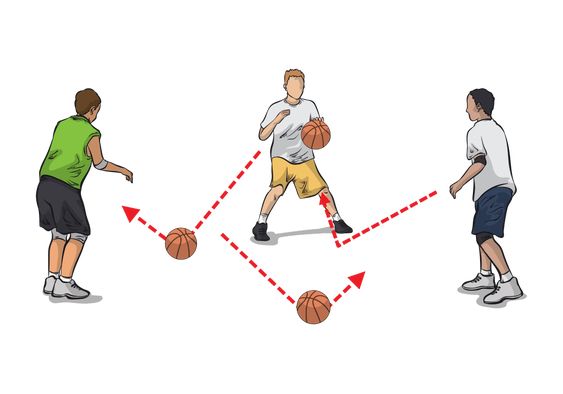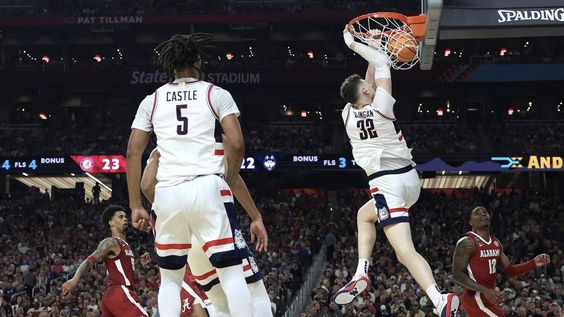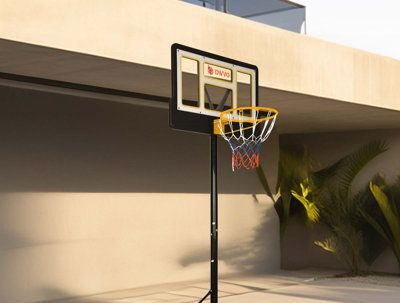What is a Dime in Basketball?
In basketball, a “dime” is a slang term for an assist. An assist occurs when a player passes the ball to a teammate in a way that leads to a score. Think of it as setting up a friend for success. If Player A passes the ball to Player B, and Player B then scores, Player A gets credit for an assist. The term “dime” is used to celebrate these crucial passes, highlighting the teamwork and vision involved in making the play.
The Origin of the Term ‘Dime’
The exact origin of the term “dime” in basketball is somewhat unclear, but there are a few theories. One popular idea is that it comes from the old practice of paying a dime (10 cents) for a phone call. Just as a dime helped connect people on the phone, an assist connects players on the court. Another theory is that it’s related to the phrase “dropping a dime,” which means giving something valuable, like a tip or information. In basketball, giving a perfect pass is like giving a valuable gift to your teammate. Also, read about How Big is a Basketball Rim
Importance of Assists in Basketball
Assists are a vital part of basketball for several reasons:
- Teamwork and Cooperation: Basketball is a team sport, and assists highlight the importance of working together. A good assist shows that players are looking out for each other and willing to share the ball.
- Creating Opportunities: Assists often lead to easier scoring opportunities. A well-timed pass can find a player in a perfect position to score, making the team’s offense more effective.
- Game Flow: Assists help keep the game flowing smoothly. Instead of one player trying to do everything alone, the ball moves around, making it harder for the defense to keep up.
Famous Players Known for Their Dimes
Throughout basketball history, some players have become legendary for their ability to dish out dimes. Here are a few notable examples:
- Magic Johnson: Known for his incredible vision and flashy passes, Magic Johnson is often considered one of the best passers in NBA history. His ability to find teammates in perfect scoring positions was unmatched.
- John Stockton: Stockton holds the NBA record for most career assists. His precise and consistent passing made him a key player for the Utah Jazz for many years.
- Steve Nash: Nash was known for his creativity and ability to make difficult passes look easy. His time with the Phoenix Suns showcased his exceptional playmaking skills.
- LeBron James: While LeBron is often celebrated for his scoring, he’s also an outstanding passer. His combination of size, skill, and basketball IQ allows him to make incredible assists.
How to Make a Great Assist
Making a
great assist involves a combination of skill, vision, and timing. Here are some key elements to focus on if you want to improve your ability to dish out dimes on the court:
- Court Vision: To make great passes, you need to see the entire court and anticipate where your teammates and opponents will be. This involves keeping your head up and being aware of everyone’s positions at all times.
- Communication: Non-verbal cues like eye contact, hand signals, and body language can help you communicate with your teammates. Sometimes, a quick glance is all it takes to signal where you want your teammate to go.
- Timing: The best passes are made at the perfect moment. You need to deliver the ball right when your teammate is in the best position to score, which often means passing the ball before they even get there.
- Precision: Accuracy is crucial. A good pass should hit your teammate in the right spot, whether it’s in their shooting pocket, leading them to the basket, or simply keeping it away from defenders.
- Variety of Passes: Different situations call for different types of passes. Practice chest passes, bounce passes, overhead passes, and more to ensure you can handle any scenario.
For more information northernreport.ca

Practicing Your Passing Skills
Improving your ability to make assists requires practice. Here are some drills and exercises that can help:
- Partner Passing Drills: Pair up with a teammate and practice different types of passes. Focus on accuracy and timing.
- Obstacle Drills: Set up cones or other obstacles to simulate defenders. Practice passing around these obstacles to improve your ability to make passes under pressure.
- Vision Drills: Work on keeping your head up while dribbling and scanning the court. This helps you develop the habit of always being aware of your surroundings.
- Fast Break Drills: Simulate fast break scenarios where you have to make quick decisions and precise passes while moving at high speed.
- Game Situations: Play in scrimmages or pick-up games to apply your passing skills in real game situations. The more you practice in a game-like environment, the better you’ll become at making assists under pressure.
The Role of the Point Guard
In basketball, the point guard is often the primary playmaker and is typically responsible for handling the ball and setting up the offense. They are usually the ones who rack up the most assists. Here’s why the point guard position is crucial for distributing dimes:
- Ball Handling: Point guards are usually the best ball handlers on the team, which allows them to navigate through defenders and find open teammates.
- Leadership: Point guards act as the on-court leaders, directing teammates and making strategic decisions during the game.
- Playmaking: They need to have a deep understanding of the game and their team’s playbook to effectively run plays and create scoring opportunities.
- Speed and Agility: Quick movements and the ability to change direction rapidly help point guards create space and opportunities to pass.
Assists and Advanced Statistics
In modern basketball, advanced statistics have become increasingly important. Here are some metrics related to assists that help evaluate a player’s playmaking ability:
- Assist Percentage (AST%): This statistic measures the percentage of a team’s field goals that a player assisted on while they were on the court. It provides insight into a player’s role in the team’s offense.
- Assist-to-Turnover Ratio: This ratio compares the number of assists a player makes to the number of turnovers they commit. A high assist-to-turnover ratio indicates efficient and effective playmaking.
- Secondary Assists: Sometimes called “hockey assists,” these are passes that lead to an assist. It’s a way to recognize the player who made the pass that set up the scoring pass.
- Potential Assists: This statistic counts passes that would have been assists if the receiver made the shot. It highlights a player’s ability to create scoring opportunities even if they don’t always result in points.
Memorable Assists in Basketball History
There have been countless memorable assists in basketball history, moments that not only resulted in points but also left fans in awe. Here are a few iconic examples:
- Magic Johnson’s No-Look Passes: Magic Johnson was famous for his no-look passes, where he would look one way while passing the ball another. These passes often caught defenders off guard and led to easy baskets.
- Steve Nash’s Behind-the-Back Passes: Nash had a knack for delivering behind-the-back passes that threaded through defenders and landed perfectly in his teammate’s hands.
- LeBron James’ Full-Court Passes: LeBron is known for his incredible full-court passes that travel the length of the court with pinpoint accuracy, leading to quick and easy scores.
- Jason Williams’ Elbow Pass: In the 2000 Rookie Challenge, Jason “White Chocolate” Williams executed an unbelievable pass where he bounced the ball off his elbow to a teammate, leaving the crowd stunned.
The Evolution of the Assist
The concept of the assist has evolved over the years as the game of basketball has changed. Here are a few ways in which assists have developed:
- Changing Play Styles: The pace and style of basketball have changed over the decades. The fast-paced, high-scoring game of today creates more opportunities for assists compared to the slower, more methodical play of the past.
- Three-Point Revolution: With the increased focus on three-point shooting, assists have become more valuable. Passing out to open shooters beyond the arc can lead to high-scoring plays.
- Positionless Basketball: Modern basketball often features players who can play multiple positions. This has led to more players, not just point guards, accumulating high assist numbers.
- Advanced Analytics: The use of advanced statistics has helped teams understand the value of assists and playmaking, leading to a greater emphasis on ball movement and team-oriented play.
Assists in Different Levels of Play
Assists are important at all levels of basketball, from youth leagues to the NBA. Here’s how they manifest in various levels of play:
- Youth Basketball: At the youth level, coaches often emphasize the importance of passing and teamwork. Learning to make good passes and set up teammates for success is a key part of player development.
- High School Basketball: As players develop their skills, the importance of assists becomes even more pronounced. High school teams that move the ball well often have more success on the court.
- College Basketball: In college, the level of competition increases, and so does the complexity of offensive schemes. Assists are crucial in executing plays and breaking down tough defenses.
- Professional Basketball: At the professional level, assists are a key part of the game. Teams with high assist numbers are often more successful, as ball movement and teamwork become critical to scoring efficiently.

Celebrating the Dime
Assists are celebrated in various ways, both by fans and players. Here are some ways the basketball community honors great passing:
- Highlights and Replays: Spectacular assists often make the highlight reels and are replayed on sports shows and social media.
- Statistics and Records: Fans and analysts keep track of assist records and celebrate players who achieve high numbers of assists in a game, season, or career.
- Awards and Recognition: Players known for their playmaking abilities often receive awards and recognition, such as the NBA’s assist leader title.
- Team Celebrations: On the court, teams often celebrate great assists with high-fives, chest bumps, and other expressions of camaraderie and appreciation.
The Future of the Assist
As basketball continues to evolve, the role and importance of assists are likely to grow even further. Here are some trends that could shape the future of the assist:
- Technological Advances: Improved tracking technology and analytics will provide even more detailed insights into passing and playmaking, helping teams optimize their offense.
- Global Influence: As basketball becomes more popular worldwide, different styles of play and unique passing techniques from various countries will continue to influence the game.
- Youth Development: With a greater emphasis on skill development and teamwork at the youth level, future generations of players will likely be even better at making assists.
- Changing Rules and Strategies: As the rules and strategies of basketball continue to evolve, the importance of assists and the ways in which they are made may also change, keeping the game exciting and dynamic.
Conclusion
Understanding what a “dime” is in basketball opens up a deeper appreciation for the game. Assists are a beautiful demonstration of teamwork, skill, and basketball intelligence. They highlight the unselfish nature of the sport and the importance of working together to achieve success. Whether you’re a player looking to improve your passing skills or a fan wanting to understand the game better, recognizing the value of a great assist will enhance your experience of basketball. So next time you watch a game and see a player make a perfect pass leading to a score, you’ll know that they just dropped a dime.





